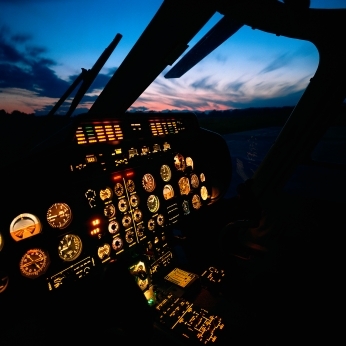 By Paul BJ Ransbury
By Paul BJ Ransbury
President of APS Emergency Maneuver Training
April 2010
In most aspects of aviation training, transfer of skill is one of the primary driving forces behind the implementation of various training devices, curricula, type conversions and the applicability of utilizing full flight simulator devices as valid skill development resources. (For a thorough explanation of the topic, please see this Transfer of Skills discussion.)
As an example, when I participated in my initial Airbus A320 rating in Miami, Florida, the course took about 6 weeks to complete in preparation for my eventual employment as a line pilot with the airline. The course was designed with several assumptions related to my established pilot skill. I already had advanced flight skills based on flying a variety of military aircraft, had an instrument rating, understood jet aircraft operations and had developed significant airmanship skills in my previous flying experience. The airline had certain expectations and a lot of my skills were taken for granted by them to consider me to be a trainable candidate in the allotted period. At the time, once I completed my type-rating course on the A320 and demonstrated proficiency flying that particular aircraft during IOE, the conversion course for the A330 was a 4-day program. That may seem to all be irrelevant to this discussion but the concept of core pilot skill versus type-specific pilot skill in relation to operating any specific aircraft safely will hit the topic of Transfer of Skill Concepts in Upset Recovery Training head-on as we proceed.
Just by reading that brief paragraph above, only hinting at the very basic highlights of how I was trusted to even get training in an Airbus, it is quite easy to see how pilots and training managers become understandably convinced all aspects of aviation training must follow a similar model. In other words, as our flying experience grows in aviation, all our skills must similarly become enhanced. As we get type-rating after type-rating, we start to take many of our basic skills as pilots for granted without realizing how just a small proportion of our flight skills in our day-to-day operations are actually type-specific.
Unfortunately, the story gets bleaker when we consider the reality of a typical pilot’s LOC-I skill. The assumption that pilots already have a safe level of measurable skill in dealing with upset scenarios outside their small flight-envelope/attitude comfort zone, is not supportable by statistics or formal research. In many ways, pilots need to be taught fundamental all-attitude flight skills as the core focus of upset recovery training as they do not have any experience whatsoever to fall back on. Even worse, in threatening upset situations, as pilots quickly become overwhelmed and start panicking on the flight controls, they tend to go with what they know. Typically, the panicking pilot has no idea their 20,000 hours of flight skills and learned flight control instincts are predominantly invalid when dealing with the loss of control in-flight threat beyond certain parameters.
 Although pilots in general are excellent students of aviation, they have not been forced to receive the right kind of training to be armed to deal with the loss of control in-flight threat. It isn’t their fault, as they are simply learning what they are expected to learn by the industry. For pilots to be truly prepared to recognize, avoid and (if necessary) recover from life-threatening airplane upset scenarios, we need to start their training from knowledge of the demonstrated fact that they have very little skill at all.
Although pilots in general are excellent students of aviation, they have not been forced to receive the right kind of training to be armed to deal with the loss of control in-flight threat. It isn’t their fault, as they are simply learning what they are expected to learn by the industry. For pilots to be truly prepared to recognize, avoid and (if necessary) recover from life-threatening airplane upset scenarios, we need to start their training from knowledge of the demonstrated fact that they have very little skill at all.
With such a dismal snapshot of pilot competence in relation to loss of control in-flight situations, how can anything be done quickly, inexpensively and in a manner that truly arms pilots with the skills necessary to save the aircraft and the lives of those they are charged to keep safe? Fortunately, with the right kind of finely tuned upset recovery training, a pilot who is incompetent to deal with a wide variety of LOC-I threats, can be given knowledge, insight skills, and stress-managing strategies that can propel them to a high state of competence in just a few days. And the most exciting part is that the skills learned are enduring, and are skills that last if – again, ‘if’ – the training is done properly.
Why is Upset Recovery Training Such a Unique Challenge?
Although this document addresses the current training industry’s lack of resources to impart all-attitude recovery skills in the typical pilot, it is important to highlight that many aspects of upset recovery training can be accomplished in a traditional manner. As we’ll see a little later, loss of control academic training, type-specific transfer of skill training and some aspects of recognition and avoidance training are well within reach of the established training model.
 OK, NOW THIS IS IT FOLKS: It is now time to say what nobody wants to say or hear (especially line pilots, flight schools and many other training institutions) :
OK, NOW THIS IS IT FOLKS: It is now time to say what nobody wants to say or hear (especially line pilots, flight schools and many other training institutions) :
The vast majority of skills that can be transferred are already being transferred. The problem is the skills that need to be transferred cannot be transferred because pilots do not have them to begin with. The primary issue in the industry’s task to produce pilots with skills necessary to address loss of control in flight is to give them the skills that they don’t have. When it comes right down to it, “Transfer of Skill” is the easy part as long as the “Core Skills” are taught properly, generically and simply.
It is our contention that more than 90% of the Transfer of Skill issue associated with upset recovery training is actually “Core Upset Recovery Skill Creation” not specifically the “Transferring of Skill”.
Recovering most any type, class or category of fixed wing aircraft from most airplane upsets involves straightforward manipulation of primary flight controls in a manner and order that maximizes the pilot’s ability to resolve the situation to recovery. Technically, the process of applying the core recovery strategy is not difficult. On the other hand, the skills required to do so are counter-intuitive to the pilot who has virtually no all-attitude flight experience of any kind. It is not a complex issue when we’re just talking about identifying the steps necessary for a pilot to recognize, avoid and, if necessary, recover an airplane from an upset. There is more to it than that.
On the down side, there is seemingly an endless supply of tips, tricks or try-this methods that float around the industry, often relayed from flight deck to flight deck, dozens – even hundreds – of times separated from the original sources that allude to recovery techniques which are quite frankly scary and too often unfounded. In some slightly more encouraging cases, the “tips” might actually work in an aerobatic aircraft but often provide no consistent application to safely recovering a non-aerobatic airframe with an untrained pilot at the controls.
A Core Upset Recovery Skill Set of Primary Control Strategies must be established as a fundamental recovery technique for all pilots, or as a minimum, commercial pilots and flight instructors. Defining the elements, application and processes that comprehend a thoroughly demonstrated and universally transferable upset recovery skill set are not the focus of this document. For further information on a thoroughly investigated, tested and practically proven Core Upset Recovery Strategy, please contact APS.
Aspirations with Future Training Developments
Transfer of Skill is a crucial factor in the development of an industry solution to the LOC-I threat. It is hoped academic, political and aviation training efforts made by APS Emergency Maneuver Training will motivate regulators, decision-makers and oversight committees to consider the following in relation to upset recovery training:
 Transfer of Skill is primarily about Core Skill Development, as pilots do not have a competent skill set pre-established.
Transfer of Skill is primarily about Core Skill Development, as pilots do not have a competent skill set pre-established.- Over 90% of the core skill development necessary for a pilot to recover an airplane from an in-flight upset is not type-specific. However, type-specific ‘differences training’ in Level D full flight simulator of a pilot’s specific aircraft type would have significant value.
- Pilots must receive specialized training to be given the fundamental tools to be able to recover any fixed-wing aircraft from a wide variety of stalled flight, unusual attitudes, upsets, control failures and wake turbulence situations. Similar to an Instrument Rating, the core concepts of how to recover a fixed wing aircraft remain relatively constant.
- Pilots must be given more than just practical skills to deal with a wide variety of airplane upsets. They must be instilled with the mental discipline to not be overwhelmed by the threatening nature of an airplane upset, be able to contain panicked over-response (i.e. contain the startle factor) and have a trained ability to draw upon counter-intuitive skills in a high-stress life-threatening environment.
- Making a measurable difference in a pilot’s ability to address LOC-I requires a specialized combination of the right kind of academics, threat assessment, decision-making, and skill development through repetition to proficiency and recurrent training. Making a minor change to how training is currently accomplished, although likely keeping regulators and training organizations comfortable will have minor results. Regulated intervention is required.
- Change will need to be mandated by the regulators and insurance agencies. Airlines, training departments and individual pilots will not use their own initiative to take skill-altering steps to address LOC-I.
- LOC-I has been appropriately noticed but, for the most part, dismissed since the beginning of aviation history and will continue to be ignored as it has been accepted that an easy solution does not exist. A solution does exist and only requires a few days of specialized training. Similar to the few hours of training mandated to receive high performance, tailwheel, complex aircraft and high altitude endorsements, a regimented requirement for all commercial pilots to have an upset recovery endorsement could potentially be aviation’s largest leap forward in history related to the improvement of safety of flight.




Comments: